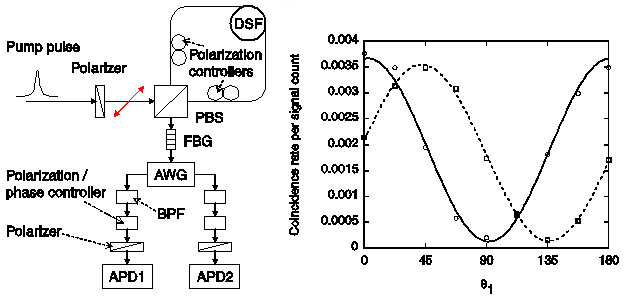using spontaneous four-wave mixing in dispersion-shifted fiber
Optical Science Laboratory
Generation of entangled photon pairs in the 1.5μm band
is one of the important technological challenges for realizing quantum communication
over optical fiber networks. We have succeeded in generating polarization
entangled photons in the wavelength band, by using spontaneous four-wave mixing
(SFWM) in a loop formed with a polarization beamsplitter (PBS) and a dispersion-shifted
fiber (DSF).
Fig. 1 shows the configuration. A pump pulse with a 45°linear polarization
is input into the loop. The PBS divides the pump into horizontal (H) and vertical
(V) polarization components. The H and V components generate signal-idler
photon pairs| H >s|H >i
、and | V >s|V >i
through a SFWM process while propagating in the loop in the counter-clockwise
and clockwise directions, respectively. These two product states are superposed
at the PBS output, the pump is then suppressed, and a polarization entangled
state(| H >s|H >i
、+ | V >s|V >i
)/√2is obtained. The loop configuration makes it possible to stabilize the
relative phase between two product states without any feedback control, and
so our system is both simple and stable.
We confirmed the feasibility of our method experimentally. We used fiber-Bragg
gratings (FBG), an arrayed waveguide grating (AWG) and bandpass filters (BPF)
to suppress the pump and separate the signal and idler photons. The signal
and idler photons were polarization-controlled and input into polarizers,
and detected using avalanche photo diodes (APD). We undertook two-photon interference
experiments, and obtained coincidence fringes with >90 % visibilities,
which is shown in Fig. 2. We then observed a violation of Bell's inequality
by seven standard deviations. We also confirmed the preservation of the quantum
correlation between the photons even after they had been separated by 20 km
optical fiber.
This result is an important step toward highly sophisticated quantum communication
networks over optical fiber.
[1] H. Takesue and K. Inoue, Phys. Rev. A, 70, 031802(R)
(2004).
 |
||
Fig. 1. Configuration |
Fig. 2. Coincidence fringes |
|